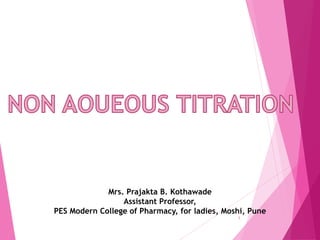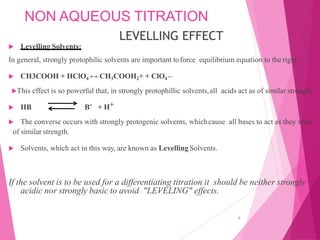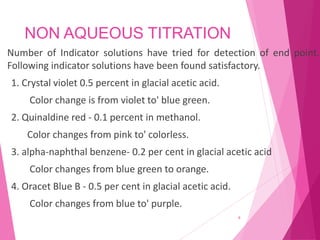NON AQUEOUS TITRATION.pptx
Download as PPTX, PDF0 likes32 views
Non-aqueous titrations are used for substances that are too weakly acidic or basic to titrate in water. The technique involves dissolving the substance and titrant in a non-aqueous solvent. There are four classes of non-aqueous solvents: protogenic solvents enhance basicity; protophillic solvents enhance acidity; amphiprotic solvents can act as acids or bases; and aprotic solvents are neutral. Common indicators used for non-aqueous titration include crystal violet, quinaldine red, and alpha-naphthal benzene. The substance being titrated can be categorized as behaving as an acid or base under the conditions, and an appropriate titrant
1 of 10
Download to read offline










Recommended
Non aqueous titration (AB-Production) IUB-BWP



Non aqueous titration (AB-Production) IUB-BWPAwais Basit
╠²
This document discusses non-aqueous titration. It defines non-aqueous titration as the titration of weakly acidic or basic substances using non-aqueous solvents to obtain a sharp endpoint. It describes the types of non-aqueous solvents that can be used, including aprotic, protogenic, protophilic, and amphiprotic solvents. Some common indicators used in non-aqueous titrations and their color changes are also outlined. Advantages include the ability to titrate organic substances that are insoluble in water and selectively titrate mixtures. Disadvantages include the need for strict temperature and moisture control along with the use of expensive and sometimes toxic or volatile solvents.Non aqueous titration



Non aqueous titrationZainab&Sons
╠²
Non-aqueous titration involves titrating substances that are not soluble or do not have a sharp endpoint in water using a non-aqueous solvent. The choice of solvent can affect whether a substance acts as a strong acid or base. Various types of non-aqueous solvents exist including aprotic, protogenic, protophilic, and amphiprotic solvents. Visual indicators are typically used to detect the endpoint in non-aqueous titrations. Some common indicators include crystal violet, oracet blue B, and quinaldine red. Non-aqueous titrations allow for the analysis of organic acids and bases that cannot be easily analyzed using aqueous titration.Volumetric analysis Pharmaceutical Chemistry.pptx



Volumetric analysis Pharmaceutical Chemistry.pptxsakshideogademcpc
╠²
Volumetric analysis, also known as titrimetric analysis, is a widely used quantitative analytical technique in chemistry to determine the concentration of an unknown substance. This method relies on the measurement of the volume of a standard solution (titrant) required to react completely with the analyte (substance being analyzed). The process is highly accurate and precise, making it an essential tool in both academic and industrial laboratories.
Principles of Volumetric Analysis
The underlying principle of volumetric analysis is based on a chemical reaction of known stoichiometry between the titrant and the analyte. By knowing the volume of the titrant and its concentration, the amount of the analyte can be calculated using the mole ratio from the balanced chemical equation.
Key factors that contribute to the accuracy of volumetric analysis include:
Precise Measurement: Accurate measurement of volumes using calibrated apparatus like burettes, pipettes, and volumetric flasks.
Known Concentration: The titrant must have a precisely known concentration, often prepared as a standard solution.
Clear Endpoint: A detectable change, often indicated by a color change using an appropriate indicator, signals the completion of the reaction.
Types of Volumetric Analysis
Volumetric analysis can be classified based on the type of reaction involved:
1. Acid-Base Titration
2. Non- aqueous titration
3. Redox Titration
4. Precipitation Titration
5. Complexometric Titration
Apparatus:
Burette: For dispensing the titrant accurately.
Pipette: For measuring and transferring a specific volume of the analyte solution.
Volumetric Flask: For preparing standard solutions.
Indicators: Substances that show a visible change (e.g., color change) at the endpoint.
Procedure:
A known volume of the analyte is measured using a pipette and transferred to a conical flask.
The titrant is added slowly from a burette to the analyte while mixing continuously.
An indicator is used to detect the endpoint of the reaction, indicated by a color change or other observable phenomenon.
The volume of the titrant used is recorded, and the analyte's concentration is calculated using the formula: C1V1=C2V2
C1 & C2 are the concentration.Non-aqueous Titration



Non-aqueous Titrationshubhambossu
╠²
The document discusses non-aqueous titration, including what it is, the role of solvents, types of non-aqueous solvents, detection of endpoints, indicators used, and references. Non-aqueous titration involves titrating substances that are not soluble in water using non-aqueous solvents. It outlines the main types of non-aqueous solvents and visual indicators commonly used to detect the endpoints in non-aqueous titrations.Non aq. titration



Non aq. titrationsumel ashique
╠²
This document discusses non-aqueous titration and provides details about the process. It describes the four main types of non-aqueous solvents used - aprotic, protogenic, protophilic, and amphiprotic. The presence of water can interfere with titrations between weak acids and bases by making the titration between a strong and weak system. The basic principles of non-aqueous titration involve the formation of onium ions or acetate ions to create a strong acid or base. Common indicators and procedures for preparing and standardizing perchloric acid are also outlined.NON-AQEUOUS TITRATION.pdf



NON-AQEUOUS TITRATION.pdfGraceShajiChittilapp
╠²
Non-aqueous titration, Introduction, Theory & Principle, Solvents & Types of solvents, Indicator, Types of Non-aqueous titration, Methods of determination of end point, Assay of Sodium benzoateunit-II (Acid base titration).pptx



unit-II (Acid base titration).pptxLaxmidharSahoo11
╠²
This document discusses acid-base titration and indicators. It defines acid-base titration as a quantitative analysis that involves neutralizing an acid or base of unknown concentration with an acid or base of known concentration. The equivalence point occurs when the titrant has exactly neutralized the analyte and allows calculating the concentration of the unknown acid or base. It also describes the Ostwald and quinonoid theories for how acid-base indicators work by changing color depending on their state of ionization or structural form under acidic or basic conditions.Non Aqueous Titration- by Dr. A. Amsavel



Non Aqueous Titration- by Dr. A. AmsavelDr. Amsavel A
╠²
This document discusses principles of non-aqueous titration and its applications in pharmaceutical industries. It describes the limitations of aqueous titration and how non-aqueous titration overcomes them. Various types of solvents used in non-aqueous titration are defined including aprotic, protogenic, protophilic and amphiprotic solvents. Acid-base theories, choice of titrants and endpoints, indicators and potentiometric titration are also covered. The document emphasizes the importance of solvent selection and various techniques to improve accuracy in non-aqueous titration.Non aqueous titration



Non aqueous titrationmeraj khan
╠²
This document discusses non-aqueous titrations, which are used to analyze organic acids and bases that are insoluble or weakly reactive in water. It describes the principles, reasons for using non-aqueous titrations, common solvents like acetic acid, and provides examples of procedures to titrate drugs like ephedrine hydrochloride and sodium benzoate. The key steps involve dissolving the analyte in a non-aqueous solvent, titrating with an acid or base, and determining the endpoint using an indicator reaction.Non aqueous titration, nonaqueous indicator,analysis of Sodium benzoate, non ...



Non aqueous titration, nonaqueous indicator,analysis of Sodium benzoate, non ...Vandana Devesh Sharma
╠²
Introduction
The theory behind non-aqueous titrations, Bronsted lowry acid base theory, Reasons for non aqueous titration, Advantage, Disadvantage, Classification of nonaqueous titration
1.Acidimetry titration
2.Alkalimetry titration
Example of Acidimetry and Alkalimetry titrations
Standardization of acid titrant-- by Potassium Hydrogen Phthalate
-Tri- (hydroxymethyl) aminomethane
-diphenyl guanidine
anhydrous sodium carbonat
Standardisation of basic titrant- by -Benzoic acid -Phenyl cinchonic acid
Types of solvent used- Amphiprotic solvent
Aprotic solvents
Protophillic solvents
Protogenic solvents
Effects of Solvents
Leveling effect
Differentiating effect
Indicators used in non-aqueous titration:
Crystal violet indicator
Methyl red indicator
Naphtholbenzein indicator
Quinaldine red, Thymol blue
Estimation of Sodium benzoate- Preparation of 0.1N solution of HClO4 and its standardization, Assay Procedure, indicator- add few drops of 5% w/v crystal violet in glacial acetic acid as indicator
Estimation of Ephedrine Hydrochloride by NAT
1. Give two example of any two nonaqueous indicator-2
2. Give assay procedure for quantitative analysis of Sodium benzoate. 5
3. Explain the various solvent used in non-aqueos titration. 5
4. Name the two drugs assayed by non aqueous titration. 2
5. Give various types of solvents used in non aqueous titration. 5
6. Mention the solvents used in non aqueous titration. 2
7. Write the exhaustive note on Sodium Benzoate. 5
8. List the type of solvent in non aqueous titration. 5
9. Name two drugs assayed by non aqueous titration. 2
10. Give various types of solvents used in non aqueous titrations. 5
11. What are non aqueous titrations? Explain non aqueous titration of ephedrine.
Give the example of solvents for non aqueous titration. 2
12. Discuss the principle methods involved in estimation of sodium benzoate ans ephedrine HCl
ANALYTICAL METHODS 



ANALYTICAL METHODS Bhavesh Amrute
╠²
This document provides an introduction to analytical methods used in pharmaceutical analysis. It discusses various classical analytical methods like titrimetric methods including acid-base titrations, precipitation titrations, complexometric titrations and instrumental methods. It also summarizes different types of analytical techniques classified as classical methods, separation methods, spectroscopic methods, electrochemical methods and thermal methods. Specific techniques discussed in detail include acid-base titrations, indicators used in titrations, and types of complexometric titrations. The document provides an overview of key concepts and methods in pharmaceutical analytical chemistry.Lecture 1 - PH and Litmus paper



Lecture 1 - PH and Litmus papersoft worker
╠²
In chemistry, pH (potential of hydrogen) is a numeric scale used to specify the acidity or basicity of an aqueous solution. It is approximately the negative of the base 10 logarithm of the molar concentration, measured in units of moles per liter, of hydrogen ions.chemical Indicators



chemical IndicatorsKirti Garg
╠²
Indicators are chemical substances that change color based on whether a solution is acidic or basic. Common acid-base indicators include litmus, methyl orange, and phenolphthalein. They change color at specific pH levels, allowing for the determination of a solution's acidity or basicity. Other types of indicators include universal indicators, which change color gradually over a wide pH range, olfactory indicators detected by smell, and redox indicators sensitive to oxidation-reduction reactions. Indicators find uses in titrations, testing soils and swimming pools, and monitoring wastes.Non aqueous acid-base titrations



Non aqueous acid-base titrationsSai Datri Arige
╠²
This document discusses non-aqueous titration. It explains that non-aqueous titration uses solvents other than water and can titrate organic compounds that are insoluble in water. The key aspects covered include the theory behind acid-base chemistry in different solvents, properties of non-aqueous solvents, factors in solvent selection, and applications like titrating weak acids and bases. Detection methods for non-aqueous titration include potentiometric and indicator-based methods.Buffer solution



Buffer solutionBahauddin Zakariya University lahore
╠²
1. A buffer solution maintains a fairly constant pH upon the addition of small amounts of acid or base. There are two types: acidic buffers containing a weak acid and salt of that acid, and basic buffers containing a weak base and salt of that base.
2. Buffer solutions resist changes in pH when acids or bases are added. The buffer capacity depends on the concentrations of the buffer components and how close the pKa is to the solution's pH.
3. Common acid-base indicators like phenolphthalein and methyl orange change color over a specific pH range, signaling the endpoint in acid-base titrations.Non Aqueous Titrations



Non Aqueous TitrationsAhmad Hasan FaiZi
╠²
Non-aqueous titration allows for the titration of weak acids and bases that cannot be accurately measured in aqueous solution. It involves titrating the substance using a non-aqueous solvent and titrant. Various organic solvents like acetic acid, alcohols, and amines can be used that compete less than water for proton donation or acceptance. This allows for sharper endpoints compared to titration in water for very weak acids and bases. Selection of the appropriate non-aqueous solvent depends on factors like solubility of the sample and ability to produce a clear endpoint.VOLUMETRIC ANALYSIS.pdf



VOLUMETRIC ANALYSIS.pdfBALASUNDARESAN M
╠²
This document discusses volumetric analysis and redox titration methods. It provides definitions of key terms like concentration, solutions, percentage compositions, and titration. It describes different types of titration including neutralization, non-aqueous, and redox titration. Neutralization titration can involve strong acid/strong base, weak acid/strong base, or weak acid/weak base reactions. Indicators are used to detect the endpoint of titrations. Redox titration involves oxidation-reduction reactions, and iodine is commonly used as an oxidizing agent in direct redox titrations.D. pharm nonaqueous titration short notes.pptx



D. pharm nonaqueous titration short notes.pptxVandana Devesh Sharma
╠²
Non Aqueous titration
Definition-Titration which are carried out in the absence of aqueous medium are called non aqueous titration.
Non-aqueous titration is a type of titration in which weakly acidic or basic analytes are carried out in a solvent medium that does not contain water. The solute is dissolved in a non-aqueous solvent and titrated with an acid or base titrant.╠²
Non Aqueous titration
Definition-Titration which are carried out in the absence of aqueous medium are called non aqueous titration.
Non-aqueous titration is a type of titration in which weakly acidic or basic analytes are carried out in a solvent medium that does not contain water. The solute is dissolved in a non-aqueous solvent and titrated with an acid or base titrant.╠²
Reasons for non aqueous titration
Advantage and disadvantage
classification- Acidimetry, Alkalimetry
Example of Titrant, titrand, indicators and solvent used in Nonaqueous titration,
Most Common acidic titrant- Perchloric acid in glacial acetic acid
Most commonly used basic titrant- Methoxide of sod. or pot. Or lithium - tetra butylammonium hydroxide
Type of non aqueous solvents
Solvent play an important role in non aqueous titration because that solvent supports the disassociation of weak acids or base and alter the behavior of analyte. Non aqueous solvents majorly classified into 4 types
Amphiprotic solvent
Aprotic solvents
Protophillic solvents
Protogenic solvents
Effects of Solvents
Leveling effect
Differentiating effect
Leveling effect- Weak acids and bases are normally used in the presence of strong protophilic (pyridine, Liquid ammonia) and strong photogenic solvents (HF and Sulphuric acid ) because their strengths is enhanced by these solvents.
Differentiating effect
In less basic non aqueous solvent like glacial acetic acid --------dissociation of different acids varies i.e. dissociation of perchloric acid is more as compared to HCl.
Therefore, in glacial acetic acid- perchloric acid act as a strong acid as compare to HCl
This effect of differentiating between strength of acids is called differentiating effect and the solvent like glacial acetic acid etc which show this effect are called differentiating solvents.
Commonly used solvents in Non-aqueous titration
Glacial acetic acid/ethanolic acid
Acetonitrile
Alcohals
Dioxane
Dimethyl formide (DMF)
Indicators used in non-aqueous titration:Indicators used in non-aqueous titration:
In a non-aqueous titration, visual indicators are most appropriate for detecting the endpoint or equivalence point of the reaction.
The indicators used in non-aqueous titrations are as follows
For non-aqueous titration, the ionised and unionised form, or various resonant form of indicators are all generally applicable, however, the color change at the endpoint of reaction differ from titration to titration according to the nature of the titrant.
Crystal violnon-aqueous-titration FOR PHARM ANALYSIS.pptx



non-aqueous-titration FOR PHARM ANALYSIS.pptxSajidHussain495712
╠²
The document discusses non-aqueous titrations, which involve dissolving the analyte substance in a non-aqueous solvent rather than water. This is necessary when water could compete with or interfere with the reaction of weak acids and bases. The key advantages of non-aqueous titrations are that they can titrate very weak acids/bases and dissolve organic compounds. The document describes different types of non-aqueous solvents and how indicators and titrants are selected for particular analytes.Non aqueous titration



Non aqueous titrationManishaPanwar13
╠²
Non-aqueous titration is used when the analyte is insoluble, reactive, or too weak to be titrated in water. The amphoteric nature of water can interfere with titration of weak acids or bases. Key aspects include:
- Using a non-aqueous solvent like acetic acid or DMF that is inert, acidic, or basic as needed.
- Titrants like perchloric acid or potassium methoxide that are appropriate for the analyte and solvent.
- Visual indicators that change color at the endpoint, selected based on the solvent system.
- Potentiometric titration can also detect the endpoint.
- Temperature, moisture and CO2 must beNon aqueous titration 04.06.2021



Non aqueous titration 04.06.2021RajiniKanthNarasimhu
╠²
This document provides an overview of non-aqueous titration as a technique used in pharmaceutical analysis. It discusses the need for non-aqueous titrations when analytes are not soluble or reactive in water. The principles and techniques of non-aqueous acid-base titration are explained, including the use of aprotic, protogenic, amphiprotic and protophilic solvents. Common titrants, indicators, and examples of pharmaceutical compounds analyzed by non-aqueous titration like sodium benzoate and ephedrine hydrochloride are outlined. The document also provides procedures for standardizing titrants and estimating drugs using this analytical method.non aqueous titrations of acid and base .pptx



non aqueous titrations of acid and base .pptxDeepali69
╠²
Non-aqueous titrations allow for the titration of substances that cannot be titrated in aqueous solutions, such as mixtures of acids/bases, organic acids/bases insoluble in water, and very weak acids/bases. Solvents used include acetic acid, acetonitrile, alcohols, and DMF. Indicators change color in acidic and basic conditions. Common titrations include primary/secondary/tertiary amines with perchloric acid and acids with sodium/potassium methoxide. Proper preparation of titrants and indicators, choice of solvent, and accounting for temperature effects are important for accurate non-aqueous titrations.Indicator



Indicatorifrah fahim
╠²
This document defines and describes various types of indicators used to determine the acidity, alkalinity or redox state of a solution. It discusses natural indicators like turmeric and litmus, as well as artificial pH indicators like methyl orange and phenolphthalein. It also covers complexometric, adsorption and universal indicators, and provides examples of how different indicators are used to test solutions and determine the endpoint in titration reactions.Non aqueous titration



Non aqueous titrationYasminMomin3
╠²
Non-aqueous titrations allow for the titration of weakly acidic or basic substances using non-aqueous solvents. This provides sharper endpoints compared to aqueous titrations. Common non-aqueous solvents include acetic acid, acetonitrile, alcohols, and dimethylformamide. Indicators are also used that change color at the titration endpoint. Examples given are the titration of ephedrine hydrochloride and sodium benzoate using perchloric acid in acetic acid with crystal violet indicator.Non aqueous titration Exp 8, 9 final.docx



Non aqueous titration Exp 8, 9 final.docxnirman17
╠²
Non-aqueous titration involves dissolving the analyte in a non-aqueous solvent instead of water. This is necessary when water could compete with the analyte as a weak acid or base, making the endpoint difficult to detect. Non-aqueous solvents are also used when the analyte or products are insoluble in water or react with water. Common non-aqueous solvents include aprotic solvents like benzene which do not favor ionization, and protophilic solvents like alcohols which accept protons. Amphiprotic solvents like acetic acid can both donate and accept protons. Non-aqueous titration allows for the accurate titration of very weak acids and bases andNon Aqueous Acid Base Titration



Non Aqueous Acid Base TitrationZahir Khan
╠²
This presentation summarizes non-aqueous acid-base titration. It introduces the presenter, MD. Zahirul Isalam from the Department of Pharmacy at World University of Bangladesh. The presentation defines non-aqueous titration as titrating weakly acidic or basic substances using non-aqueous solvents to get a sharp endpoint. It discusses the different types of non-aqueous solvents including aprotic, protophilic, protogenic, and amphiprotic solvents. The presentation also covers determining the endpoint through potentiometric or indicator methods and describes examples of titrating weak bases and acids through non-aqueous methods.Glycolysis.pptx



Glycolysis.pptxprajakta kothawade
╠²
Glycolysis is the pathway that converts glucose to pyruvate, generating a small amount of ATP. The liver plays a key role in monitoring and stabilizing blood glucose levels. Glycolysis occurs through three phases: 1) energy investment where glucose is phosphorylated, 2) splitting of a six-carbon molecule into two three-carbon molecules, and 3) energy generation where ATP is produced from the breakdown of the three-carbon molecules. The pathway generates 2 ATP per glucose under anaerobic conditions and up to 8 ATP per glucose under aerobic conditions using shuttle pathways to further oxidize NADH in the mitochondria.Enzymes.pptx



Enzymes.pptxprajakta kothawade
╠²
This document provides information about enzymes. Some key points:
- Enzymes are protein catalysts that speed up chemical reactions without being consumed. They have specific active sites that substrates bind to in order to undergo reactions.
- There are six major classes of enzymes based on the type of reaction they catalyze: oxidoreductases, transferases, hydrolases, lyases, isomerases, and ligases.
- Enzymes exhibit specificity in terms of the substrates, reactions, and stereoisomers they act on. Their active sites allow for selective binding.
- In addition to the protein component, some enzymes require cofactors like metals ions or coenzymes to function properlyMore Related Content
Similar to NON AQUEOUS TITRATION.pptx (20)
Non Aqueous Titration- by Dr. A. Amsavel



Non Aqueous Titration- by Dr. A. AmsavelDr. Amsavel A
╠²
This document discusses principles of non-aqueous titration and its applications in pharmaceutical industries. It describes the limitations of aqueous titration and how non-aqueous titration overcomes them. Various types of solvents used in non-aqueous titration are defined including aprotic, protogenic, protophilic and amphiprotic solvents. Acid-base theories, choice of titrants and endpoints, indicators and potentiometric titration are also covered. The document emphasizes the importance of solvent selection and various techniques to improve accuracy in non-aqueous titration.Non aqueous titration



Non aqueous titrationmeraj khan
╠²
This document discusses non-aqueous titrations, which are used to analyze organic acids and bases that are insoluble or weakly reactive in water. It describes the principles, reasons for using non-aqueous titrations, common solvents like acetic acid, and provides examples of procedures to titrate drugs like ephedrine hydrochloride and sodium benzoate. The key steps involve dissolving the analyte in a non-aqueous solvent, titrating with an acid or base, and determining the endpoint using an indicator reaction.Non aqueous titration, nonaqueous indicator,analysis of Sodium benzoate, non ...



Non aqueous titration, nonaqueous indicator,analysis of Sodium benzoate, non ...Vandana Devesh Sharma
╠²
Introduction
The theory behind non-aqueous titrations, Bronsted lowry acid base theory, Reasons for non aqueous titration, Advantage, Disadvantage, Classification of nonaqueous titration
1.Acidimetry titration
2.Alkalimetry titration
Example of Acidimetry and Alkalimetry titrations
Standardization of acid titrant-- by Potassium Hydrogen Phthalate
-Tri- (hydroxymethyl) aminomethane
-diphenyl guanidine
anhydrous sodium carbonat
Standardisation of basic titrant- by -Benzoic acid -Phenyl cinchonic acid
Types of solvent used- Amphiprotic solvent
Aprotic solvents
Protophillic solvents
Protogenic solvents
Effects of Solvents
Leveling effect
Differentiating effect
Indicators used in non-aqueous titration:
Crystal violet indicator
Methyl red indicator
Naphtholbenzein indicator
Quinaldine red, Thymol blue
Estimation of Sodium benzoate- Preparation of 0.1N solution of HClO4 and its standardization, Assay Procedure, indicator- add few drops of 5% w/v crystal violet in glacial acetic acid as indicator
Estimation of Ephedrine Hydrochloride by NAT
1. Give two example of any two nonaqueous indicator-2
2. Give assay procedure for quantitative analysis of Sodium benzoate. 5
3. Explain the various solvent used in non-aqueos titration. 5
4. Name the two drugs assayed by non aqueous titration. 2
5. Give various types of solvents used in non aqueous titration. 5
6. Mention the solvents used in non aqueous titration. 2
7. Write the exhaustive note on Sodium Benzoate. 5
8. List the type of solvent in non aqueous titration. 5
9. Name two drugs assayed by non aqueous titration. 2
10. Give various types of solvents used in non aqueous titrations. 5
11. What are non aqueous titrations? Explain non aqueous titration of ephedrine.
Give the example of solvents for non aqueous titration. 2
12. Discuss the principle methods involved in estimation of sodium benzoate ans ephedrine HCl
ANALYTICAL METHODS 



ANALYTICAL METHODS Bhavesh Amrute
╠²
This document provides an introduction to analytical methods used in pharmaceutical analysis. It discusses various classical analytical methods like titrimetric methods including acid-base titrations, precipitation titrations, complexometric titrations and instrumental methods. It also summarizes different types of analytical techniques classified as classical methods, separation methods, spectroscopic methods, electrochemical methods and thermal methods. Specific techniques discussed in detail include acid-base titrations, indicators used in titrations, and types of complexometric titrations. The document provides an overview of key concepts and methods in pharmaceutical analytical chemistry.Lecture 1 - PH and Litmus paper



Lecture 1 - PH and Litmus papersoft worker
╠²
In chemistry, pH (potential of hydrogen) is a numeric scale used to specify the acidity or basicity of an aqueous solution. It is approximately the negative of the base 10 logarithm of the molar concentration, measured in units of moles per liter, of hydrogen ions.chemical Indicators



chemical IndicatorsKirti Garg
╠²
Indicators are chemical substances that change color based on whether a solution is acidic or basic. Common acid-base indicators include litmus, methyl orange, and phenolphthalein. They change color at specific pH levels, allowing for the determination of a solution's acidity or basicity. Other types of indicators include universal indicators, which change color gradually over a wide pH range, olfactory indicators detected by smell, and redox indicators sensitive to oxidation-reduction reactions. Indicators find uses in titrations, testing soils and swimming pools, and monitoring wastes.Non aqueous acid-base titrations



Non aqueous acid-base titrationsSai Datri Arige
╠²
This document discusses non-aqueous titration. It explains that non-aqueous titration uses solvents other than water and can titrate organic compounds that are insoluble in water. The key aspects covered include the theory behind acid-base chemistry in different solvents, properties of non-aqueous solvents, factors in solvent selection, and applications like titrating weak acids and bases. Detection methods for non-aqueous titration include potentiometric and indicator-based methods.Buffer solution



Buffer solutionBahauddin Zakariya University lahore
╠²
1. A buffer solution maintains a fairly constant pH upon the addition of small amounts of acid or base. There are two types: acidic buffers containing a weak acid and salt of that acid, and basic buffers containing a weak base and salt of that base.
2. Buffer solutions resist changes in pH when acids or bases are added. The buffer capacity depends on the concentrations of the buffer components and how close the pKa is to the solution's pH.
3. Common acid-base indicators like phenolphthalein and methyl orange change color over a specific pH range, signaling the endpoint in acid-base titrations.Non Aqueous Titrations



Non Aqueous TitrationsAhmad Hasan FaiZi
╠²
Non-aqueous titration allows for the titration of weak acids and bases that cannot be accurately measured in aqueous solution. It involves titrating the substance using a non-aqueous solvent and titrant. Various organic solvents like acetic acid, alcohols, and amines can be used that compete less than water for proton donation or acceptance. This allows for sharper endpoints compared to titration in water for very weak acids and bases. Selection of the appropriate non-aqueous solvent depends on factors like solubility of the sample and ability to produce a clear endpoint.VOLUMETRIC ANALYSIS.pdf



VOLUMETRIC ANALYSIS.pdfBALASUNDARESAN M
╠²
This document discusses volumetric analysis and redox titration methods. It provides definitions of key terms like concentration, solutions, percentage compositions, and titration. It describes different types of titration including neutralization, non-aqueous, and redox titration. Neutralization titration can involve strong acid/strong base, weak acid/strong base, or weak acid/weak base reactions. Indicators are used to detect the endpoint of titrations. Redox titration involves oxidation-reduction reactions, and iodine is commonly used as an oxidizing agent in direct redox titrations.D. pharm nonaqueous titration short notes.pptx



D. pharm nonaqueous titration short notes.pptxVandana Devesh Sharma
╠²
Non Aqueous titration
Definition-Titration which are carried out in the absence of aqueous medium are called non aqueous titration.
Non-aqueous titration is a type of titration in which weakly acidic or basic analytes are carried out in a solvent medium that does not contain water. The solute is dissolved in a non-aqueous solvent and titrated with an acid or base titrant.╠²
Non Aqueous titration
Definition-Titration which are carried out in the absence of aqueous medium are called non aqueous titration.
Non-aqueous titration is a type of titration in which weakly acidic or basic analytes are carried out in a solvent medium that does not contain water. The solute is dissolved in a non-aqueous solvent and titrated with an acid or base titrant.╠²
Reasons for non aqueous titration
Advantage and disadvantage
classification- Acidimetry, Alkalimetry
Example of Titrant, titrand, indicators and solvent used in Nonaqueous titration,
Most Common acidic titrant- Perchloric acid in glacial acetic acid
Most commonly used basic titrant- Methoxide of sod. or pot. Or lithium - tetra butylammonium hydroxide
Type of non aqueous solvents
Solvent play an important role in non aqueous titration because that solvent supports the disassociation of weak acids or base and alter the behavior of analyte. Non aqueous solvents majorly classified into 4 types
Amphiprotic solvent
Aprotic solvents
Protophillic solvents
Protogenic solvents
Effects of Solvents
Leveling effect
Differentiating effect
Leveling effect- Weak acids and bases are normally used in the presence of strong protophilic (pyridine, Liquid ammonia) and strong photogenic solvents (HF and Sulphuric acid ) because their strengths is enhanced by these solvents.
Differentiating effect
In less basic non aqueous solvent like glacial acetic acid --------dissociation of different acids varies i.e. dissociation of perchloric acid is more as compared to HCl.
Therefore, in glacial acetic acid- perchloric acid act as a strong acid as compare to HCl
This effect of differentiating between strength of acids is called differentiating effect and the solvent like glacial acetic acid etc which show this effect are called differentiating solvents.
Commonly used solvents in Non-aqueous titration
Glacial acetic acid/ethanolic acid
Acetonitrile
Alcohals
Dioxane
Dimethyl formide (DMF)
Indicators used in non-aqueous titration:Indicators used in non-aqueous titration:
In a non-aqueous titration, visual indicators are most appropriate for detecting the endpoint or equivalence point of the reaction.
The indicators used in non-aqueous titrations are as follows
For non-aqueous titration, the ionised and unionised form, or various resonant form of indicators are all generally applicable, however, the color change at the endpoint of reaction differ from titration to titration according to the nature of the titrant.
Crystal violnon-aqueous-titration FOR PHARM ANALYSIS.pptx



non-aqueous-titration FOR PHARM ANALYSIS.pptxSajidHussain495712
╠²
The document discusses non-aqueous titrations, which involve dissolving the analyte substance in a non-aqueous solvent rather than water. This is necessary when water could compete with or interfere with the reaction of weak acids and bases. The key advantages of non-aqueous titrations are that they can titrate very weak acids/bases and dissolve organic compounds. The document describes different types of non-aqueous solvents and how indicators and titrants are selected for particular analytes.Non aqueous titration



Non aqueous titrationManishaPanwar13
╠²
Non-aqueous titration is used when the analyte is insoluble, reactive, or too weak to be titrated in water. The amphoteric nature of water can interfere with titration of weak acids or bases. Key aspects include:
- Using a non-aqueous solvent like acetic acid or DMF that is inert, acidic, or basic as needed.
- Titrants like perchloric acid or potassium methoxide that are appropriate for the analyte and solvent.
- Visual indicators that change color at the endpoint, selected based on the solvent system.
- Potentiometric titration can also detect the endpoint.
- Temperature, moisture and CO2 must beNon aqueous titration 04.06.2021



Non aqueous titration 04.06.2021RajiniKanthNarasimhu
╠²
This document provides an overview of non-aqueous titration as a technique used in pharmaceutical analysis. It discusses the need for non-aqueous titrations when analytes are not soluble or reactive in water. The principles and techniques of non-aqueous acid-base titration are explained, including the use of aprotic, protogenic, amphiprotic and protophilic solvents. Common titrants, indicators, and examples of pharmaceutical compounds analyzed by non-aqueous titration like sodium benzoate and ephedrine hydrochloride are outlined. The document also provides procedures for standardizing titrants and estimating drugs using this analytical method.non aqueous titrations of acid and base .pptx



non aqueous titrations of acid and base .pptxDeepali69
╠²
Non-aqueous titrations allow for the titration of substances that cannot be titrated in aqueous solutions, such as mixtures of acids/bases, organic acids/bases insoluble in water, and very weak acids/bases. Solvents used include acetic acid, acetonitrile, alcohols, and DMF. Indicators change color in acidic and basic conditions. Common titrations include primary/secondary/tertiary amines with perchloric acid and acids with sodium/potassium methoxide. Proper preparation of titrants and indicators, choice of solvent, and accounting for temperature effects are important for accurate non-aqueous titrations.Indicator



Indicatorifrah fahim
╠²
This document defines and describes various types of indicators used to determine the acidity, alkalinity or redox state of a solution. It discusses natural indicators like turmeric and litmus, as well as artificial pH indicators like methyl orange and phenolphthalein. It also covers complexometric, adsorption and universal indicators, and provides examples of how different indicators are used to test solutions and determine the endpoint in titration reactions.Non aqueous titration



Non aqueous titrationYasminMomin3
╠²
Non-aqueous titrations allow for the titration of weakly acidic or basic substances using non-aqueous solvents. This provides sharper endpoints compared to aqueous titrations. Common non-aqueous solvents include acetic acid, acetonitrile, alcohols, and dimethylformamide. Indicators are also used that change color at the titration endpoint. Examples given are the titration of ephedrine hydrochloride and sodium benzoate using perchloric acid in acetic acid with crystal violet indicator.Non aqueous titration Exp 8, 9 final.docx



Non aqueous titration Exp 8, 9 final.docxnirman17
╠²
Non-aqueous titration involves dissolving the analyte in a non-aqueous solvent instead of water. This is necessary when water could compete with the analyte as a weak acid or base, making the endpoint difficult to detect. Non-aqueous solvents are also used when the analyte or products are insoluble in water or react with water. Common non-aqueous solvents include aprotic solvents like benzene which do not favor ionization, and protophilic solvents like alcohols which accept protons. Amphiprotic solvents like acetic acid can both donate and accept protons. Non-aqueous titration allows for the accurate titration of very weak acids and bases andNon Aqueous Acid Base Titration



Non Aqueous Acid Base TitrationZahir Khan
╠²
This presentation summarizes non-aqueous acid-base titration. It introduces the presenter, MD. Zahirul Isalam from the Department of Pharmacy at World University of Bangladesh. The presentation defines non-aqueous titration as titrating weakly acidic or basic substances using non-aqueous solvents to get a sharp endpoint. It discusses the different types of non-aqueous solvents including aprotic, protophilic, protogenic, and amphiprotic solvents. The presentation also covers determining the endpoint through potentiometric or indicator methods and describes examples of titrating weak bases and acids through non-aqueous methods.Non aqueous titration, nonaqueous indicator,analysis of Sodium benzoate, non ...



Non aqueous titration, nonaqueous indicator,analysis of Sodium benzoate, non ...Vandana Devesh Sharma
╠²
More from prajakta kothawade (9)
Glycolysis.pptx



Glycolysis.pptxprajakta kothawade
╠²
Glycolysis is the pathway that converts glucose to pyruvate, generating a small amount of ATP. The liver plays a key role in monitoring and stabilizing blood glucose levels. Glycolysis occurs through three phases: 1) energy investment where glucose is phosphorylated, 2) splitting of a six-carbon molecule into two three-carbon molecules, and 3) energy generation where ATP is produced from the breakdown of the three-carbon molecules. The pathway generates 2 ATP per glucose under anaerobic conditions and up to 8 ATP per glucose under aerobic conditions using shuttle pathways to further oxidize NADH in the mitochondria.Enzymes.pptx



Enzymes.pptxprajakta kothawade
╠²
This document provides information about enzymes. Some key points:
- Enzymes are protein catalysts that speed up chemical reactions without being consumed. They have specific active sites that substrates bind to in order to undergo reactions.
- There are six major classes of enzymes based on the type of reaction they catalyze: oxidoreductases, transferases, hydrolases, lyases, isomerases, and ligases.
- Enzymes exhibit specificity in terms of the substrates, reactions, and stereoisomers they act on. Their active sites allow for selective binding.
- In addition to the protein component, some enzymes require cofactors like metals ions or coenzymes to function properlyTCA cycle.pptx



TCA cycle.pptxprajakta kothawade
╠²
The citric acid cycle (Krebs cycle or TCA cycle) is the most important metabolic pathway for energy production in the body. It occurs in the mitochondrial matrix and involves the oxidation of acetyl-CoA derived from carbohydrates, fats, and proteins to produce carbon dioxide, water, and the electron carriers NADH and FADH2 to drive ATP production. The cycle generates 12 ATP per acetyl-CoA molecule oxidized and also provides precursors for various biosynthetic pathways. Key steps include the condensation of acetyl-CoA with oxaloacetate to form citrate, followed by oxidative decarboxylations and hydrations that regenerate oxaloacetate and release carbon dioxideCarbohydrates.ppt



Carbohydrates.pptprajakta kothawade
╠²
This document summarizes different types of carbohydrates. It defines monosaccharides, oligosaccharides, and polysaccharides. It then discusses specific polysaccharides including starch, glycogen, cellulose, and pectin. Starch is a storage polysaccharide in plants made of amylose and amylopectin glucose chains. Glycogen serves the same function as starch in animals. Cellulose is a structural polysaccharide made of straight beta-glucose chains. Pectin is a polysaccharide found in plant cell walls.Amino acids.ppt



Amino acids.pptprajakta kothawade
╠²
Amino acids are organic compounds that contain amino and carboxyl groups. They are the building blocks of proteins. There are 20 standard amino acids that make up proteins. Amino acids can be classified based on their structure, including whether they are nonpolar, polar, or have other functional groups. The classification determines each amino acid's properties and role in protein structure and function. Some amino acids are essential to obtain through diet, while others can be synthesized in the body. Amino acids have optical activity, acid-base properties, and can absorb ultraviolet light depending on their structure. They generally exist as zwitterions at physiological pH.Basics Titration.pptx



Basics Titration.pptxprajakta kothawade
╠²
Titration involves slowly adding a solution of known concentration (the titrant) to a solution of unknown concentration until the reaction reaches the equivalence point or endpoint, which is often indicated by a color change when using an indicator.
Some key aspects of titration covered are the definition of titration, types of neutralization reactions, titration procedures, uses and properties of acid-base indicators, and different titration curves produced from strong acid-strong base, weak acid-strong base, and weak base-strong acid titrations.
Titration is widely used in laboratories due to advantages such as being a fast, accurate, precise, and affordable analytical technique that does not require highly specialized skills or knowledge to perform.PRECIPITATION TITRATTION.ppt



PRECIPITATION TITRATTION.pptprajakta kothawade
╠²
1. Precipitation involves combining two ionic species to form an insoluble product, forcing the reaction to completion. For precipitation reactions to be useful in titrimetric analysis, the precipitate must be insoluble and form rapidly and quantitatively without interference from adsorption effects. The equivalence point must also be detectable.
2. Factors that affect solubility include common ion effect, temperature, solvent, and pH. Solubility product constants describe the solubility equilibrium of slightly soluble salts. Fractional precipitation determines which salt will precipitate first when multiple anions are present.
3. Direct and indirect precipitation titrations can be used. Direct titrations detect the equivalence point by formation of a coloredPOTENTIOMETRY.ppt



POTENTIOMETRY.pptprajakta kothawade
╠²
This document discusses potentiometry and pH measurement. It begins by defining potentiometry as using a single electrode potential measurement to determine ion concentrations. A pair of electrodes is required - an indicator electrode whose potential depends on the ion concentration, and a reference electrode with a known, stable potential.
It then discusses various reference electrodes that can be used, including the standard hydrogen electrode, silver/silver chloride electrode, and calomel electrode. The glass electrode is described as well, which can be used to directly measure pH based on the potential difference across its membrane in solutions of different hydrogen ion concentrations.
Finally, it covers different types of indicator electrodes that can be used for potentiometric titrations, including electrodesAcid Base Titration.ppt



Acid Base Titration.pptprajakta kothawade
╠²
1. The document discusses acid-base theories including Arrhenius, Br├Ėnsted-Lowry, and Lewis theories. It also defines terms related to acid-base titrations such as titration, standard solution, titrant, equivalence point, and indicator.
2. Key concepts around acid-base equilibria are explained, including the autoionization of water and the dissociation constants for weak acids and bases (Ka and Kb). The Henderson-Hasselbalch equation relating pH and the concentrations of conjugate acid-base pairs in a buffer solution is also derived.
3. Methods for determining the endpoint in an acid-base titration are described, including the use of acid-Recently uploaded (20)
Unit 1 Computer Hardware for Educational Computing.pptx



Unit 1 Computer Hardware for Educational Computing.pptxRomaSmart1
╠²
Computers have revolutionized various sectors, including education, by enhancing learning experiences and making information more accessible. This presentation, "Computer Hardware for Educational Computing," introduces the fundamental aspects of computers, including their definition, characteristics, classification, and significance in the educational domain. Understanding these concepts helps educators and students leverage technology for more effective learning.One Click RFQ Cancellation in Odoo 18 - Odoo ║▌║▌▀Żs



One Click RFQ Cancellation in Odoo 18 - Odoo ║▌║▌▀ŻsCeline George
╠²
In this slide, weŌĆÖll discuss the one click RFQ Cancellation in odoo 18. One-Click RFQ Cancellation in Odoo 18 is a feature that allows users to quickly and easily cancel Request for Quotations (RFQs) with a single click.Effective Product Variant Management in Odoo 18



Effective Product Variant Management in Odoo 18Celine George
╠²
In this slide weŌĆÖll discuss on the effective product variant management in Odoo 18. Odoo concentrates on managing product variations and offers a distinct area for doing so. Product variants provide unique characteristics like size and color to single products, which can be managed at the product template level for all attributes and variants or at the variant level for individual variants.Oral exam Kenneth Bech - What is the meaning of strategic fit?



Oral exam Kenneth Bech - What is the meaning of strategic fit?MIPLM
╠²
Presentation of the CEIPI DU IPBA oral exam of Kenneth Bech - What is the meaning of strategic fit? ASP.NET Interview Questions PDF By ScholarHat



ASP.NET Interview Questions PDF By ScholarHatScholarhat
╠²
ASP.NET Interview Questions PDF By ScholarHatInterim Guidelines for PMES-DM-17-2025-PPT.pptx



Interim Guidelines for PMES-DM-17-2025-PPT.pptxsirjeromemanansala
╠²
This is the latest issuance on PMES as replacement of RPMS. Kindly message me to gain full access of the presentation. Inventory Reporting in Odoo 17 - Odoo 17 Inventory App



Inventory Reporting in Odoo 17 - Odoo 17 Inventory AppCeline George
╠²
This slide will helps us to efficiently create detailed reports of different records defined in its modules, both analytical and quantitative, with Odoo 17 ERP.Entity Framework Interview Questions PDF By ScholarHat



Entity Framework Interview Questions PDF By ScholarHatScholarhat
╠²
Entity Framework Interview Questions PDF By ScholarHatBlind spots in AI and Formulation Science, IFPAC 2025.pdf



Blind spots in AI and Formulation Science, IFPAC 2025.pdfAjaz Hussain
╠²
The intersection of AI and pharmaceutical formulation science highlights significant blind spotsŌĆösystemic gaps in pharmaceutical development, regulatory oversight, quality assurance, and the ethical use of AIŌĆöthat could jeopardize patient safety and undermine public trust. To move forward effectively, we must address these normalized blind spots, which may arise from outdated assumptions, errors, gaps in previous knowledge, and biases in language or regulatory inertia. This is essential to ensure that AI and formulation science are developed as tools for patient-centered and ethical healthcare.Full-Stack .NET Developer Interview Questions PDF By ScholarHat



Full-Stack .NET Developer Interview Questions PDF By ScholarHatScholarhat
╠²
Full-Stack .NET Developer Interview Questions PDF By ScholarHatIntellectual Honesty & Research Integrity.pptx



Intellectual Honesty & Research Integrity.pptxNidhiSharma495177
╠²
Research Publication & Ethics contains a chapter on Intellectual Honesty and Research Integrity.
Different case studies of intellectual dishonesty and integrity were discussed.Administrative bodies( D and C Act, 1940



Administrative bodies( D and C Act, 1940P.N.DESHMUKH
╠²
These presentation include information about administrative bodies such as D.T.A.B
CDL AND DCC, etc.Mastering Soft Tissue Therapy & Sports Taping



Mastering Soft Tissue Therapy & Sports TapingKusal Goonewardena
╠²
Mastering Soft Tissue Therapy & Sports Taping: Pathway to Sports Medicine Excellence
This presentation was delivered in Colombo, Sri Lanka, at the Institute of Sports Medicine to an audience of sports physiotherapists, exercise scientists, athletic trainers, and healthcare professionals. Led by Kusal Goonewardena (PhD Candidate - Muscle Fatigue, APA Titled Sports & Exercise Physiotherapist) and Gayath Jayasinghe (Sports Scientist), the session provided comprehensive training on soft tissue assessment, treatment techniques, and essential sports taping methods.
Key topics covered:
Ō£ģ Soft Tissue Therapy ŌĆō The science behind muscle, fascia, and joint assessment for optimal treatment outcomes.
Ō£ģ Sports Taping Techniques ŌĆō Practical applications for injury prevention and rehabilitation, including ankle, knee, shoulder, thoracic, and cervical spine taping.
Ō£ģ Sports Trainer Level 1 Course by Sports Medicine Australia ŌĆō A gateway to professional development, career opportunities, and working in Australia.
This training mirrors the Elite Akademy Sports Medicine standards, ensuring evidence-based approaches to injury management and athlete care.
If you are a sports professional looking to enhance your clinical skills and open doors to global opportunities, this presentation is for you.NON AQUEOUS TITRATION.pptx
- 1. 1 Mrs. Prajakta B. Kothawade Assistant Professor, PES Modern College of Pharmacy, for ladies, Moshi, Pune
- 2. NON AQUEOUS TITRATION ’üĄ The non-aqueous titrations has replaced the aqueous titrations for many substances which are either too weakly acidic or too weakly basic. ’üĄ The principle and technique of this method is simple. ’üĄ It is based on the Bronsted-Lowrey and Lewis theory of acids and bases and, the nature and influence of levelling effect of non- aqueous solvents on substances. 2
- 3. NON AQUEOUS TITRATION The chemical reaction of acid HA with base B in aqueous solution is represented as HA------ H+ +A B + H2O ------- BH+ + OH 3
- 4. NON AQUEOUS TITRATION The non-aqueous solvents which are useful in analytical work can be classified into four classes: 1. Protogenic Solvents: These are acidic solvents and they enhance the basicity, of weak bases e. g. H2SO4,Formic acid. 2. Protophillic Solvents: These solvents are basic in nature and they enhance acidity of weak acids e. g. pyridine, n-butylamine, 4
- 5. NON AQUEOUS TITRATION 3. Amphiprotic Solvents: This category of solvents behave as acid or base depending upon the substance dissolved in it. They accept or donate protons and have levelling effect on the intrinsic strength of drugs. Glacial acetic acid dioxane. 4. Aprotic Solvents : solvents like benzene, carbon tretrachloride etc. are neutral in nature. These solvents do not accept or donate- protons. These are useful in dissolving- substances thus act as solvent and are useful for diluting solutions. 5
- 6. NON AQUEOUS TITRATION LEVELLING EFFECT ’üĄ Levelling Solvents: In general, strongly protophilic solvents are important toforce equilibrium equation to the right. ’üĄ CH3COOH + HClO4 Ōåö CH3COOH2+ + ClO4ŌĆō ’üĄThis effect is so powerful that, in strongly protophillic solvents,all acids act as of similar strength. ’üĄ HB B- + H+ ’üĄ The converse occurs with strongly protogenic solvents, whichcause all bases to act as they were of similar strength. ’üĄ Solvents, which act in this way, are known as LevellingSolvents. If the solvent is to be used for a differentiating titration it should be neither strongly acidic nor strongly basic to avoid "LEVELING" effects. 6
- 7. NON AQUEOUS TITRATION The non-aqueous titrations can be categorized mainly in two classes (a) Substances which behave as base under the condition of titrations. (b) Substances which behave as acid under the conditions of titrations.. 7
- 8. NON AQUEOUS TITRATION ’üĄ Thus substances which have both acidic and basic functional group like amino acid can be titrated as acid or base under appropriate conditions of titration. ’üĄ For determination of basic substances a solution of perchloric acid in glacial acetic acid in most commonly used as titrant. ’üĄ For determination of acidic substances a solution of tetrabutyl ammonium hydroxide in four volume of anhydrous toluene and one volume of anhydrous methanol is most commonly used as titrant. ’üĄ 8
- 9. NON AQUEOUS TITRATION Number of Indicator solutions have tried for detection of end point. Following indicator solutions have been found satisfactory. 1. Crystal violet 0.5 percent in glacial acetic acid. Color change is from violet to' blue green. 2. Quinaldine red - 0.1 percent in methanol. Color changes from pink to' colorless. 3. alpha-naphthal benzene- 0.2 per cent in glacial acetic acid Color changes from blue green to orange. 4. Oracet Blue B - 0.5 per cent in glacial acetic acid. Color changes from blue to' purple. 9
- 10. References ’üĄ VogelŌĆÖs Text Book of Quantitative Chemical Analysis, 6/Ed., Pearson Education, page no:41-50 and 363-383. ’üĄ Practical Pharmaceutical Chemistry Part-I by Beckett A H & Stanlake J B, 4/Ed., CBS Publisher & Distributors, page no:137-157 and 165. ’üĄ Pharmaceutical Analysis Vol. I & K. R. Mahadik, S.G. Wadodkar, H. N, I. More, Nirali Prakashan page no: 52-84. 10








